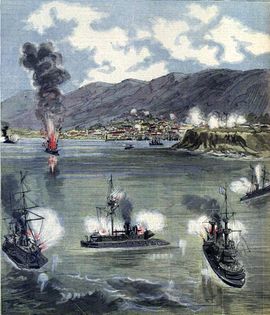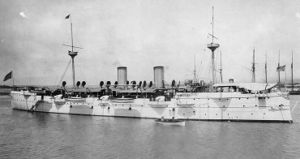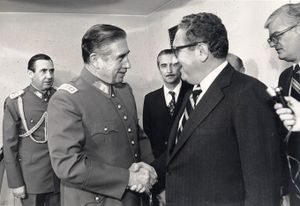التدخل الأمريكي في تشيلي
التدخل الأمريكي في السياسة التشيلية بدأ أثناء حرب الاستقلال التشيلية. وتصاعد نفوذ الولايات المتحدة في المجالين الاقتصادي والسياسي في تشيلي تدريجياً على مر قرنين من الزمان، ومازال كبيراً.
الاستقلال التشيلي
The arrival of Joel Roberts Poinsett, in 1811, marked the beginning of U.S. involvement in Chilean politics. He had been sent by President James Madison in 1809 as a special agent to the South American Spanish colonies (a position he filled from 1810 to 1814) to investigate the prospects of the revolutionaries, in their struggle for independence from Spain.
حرب الهادي
 مقالة مفصلة: حرب الهادي
مقالة مفصلة: حرب الهادي
The United States tried to bring an early end to the War of the Pacific, lasting from 1879 until 1884, mainly because of US business and financial interests in Peru. Moreover, its leaders also worried that the United Kingdom would take economic control of the region through Chile.[1] Peace negotiations failed when a stipulation required Chile to return the conquered lands. Chileans suspected the new US initiative was tainted with a pro-Peruvian bias. As a result, relations between Chile and the United States took a turn for the worse.[2] Chile instead asked that the United States remain neutral. The United States Navy only contained a few wooden vessels, and Chile had two new armored warships. The U.S. knew they were unable to match Chilean naval power and backed down.[3]
هلع حرب 1891

أثناء الحرب الأهلية التشيلية 1891، ساندت الولايات المتحدة الرئيس José Manuel Balmaceda, as a way to increase their influence in Chile, while the UK backed the Congressional forces. After the defeat of Balmaceda, the U.S. was determined to assert their influence in Chilean domestic affairs (then dominated by the victorious Congress) by any means, including war, pushing out British interests in the region.[بحاجة لمصدر]
حادث إيتاتا
The Itata incident concerned an attempted arms shipment by the ship Itata from the U.S. to Chile in 1891, destined to assist the insurgent Congressional forces. The Itata Incident was the direct cause of the Baltimore Crisis and is one of the reasons that Benjamin Harrison was not reelected to a second term as the President of the United States.
أزمة بلتيمور

After the Itata left Iquique to return to the U.S., the crew of the Baltimore took shore leave at Valparaiso. During the US sailors' shore leave on October 16, 1891, a mob of enraged Chileans angry about the Itata's capture (among other possible motives), attacked the sailors from the Baltimore. Two sailors were killed, and several were seriously wounded. That Valparaiso riot prompted saber rattling from enraged US officials, threatening war against Chile, which by now was controlled by victorious Congressional forces. A war between the U.S. and Chile was ultimately averted when the Chilean government bowed, and while maintaining that the seamen were to blame for the riot offered to pay an indemnity of $75,000 to the victims' families.
النصف الأول من القرن العشرين
United States involvement in Chilean affairs intensified in the early decades of the 20th century. After World War I, the United States replaced Britain as the leading superpower controlling most of Chile's resources, as most economic activity in the country lay in US hands. Such a change prevented Chile from profiting as a result of the war and gaining its financial independence. The dependence on the United States formally began in the early years of the 1920s as two major US companies Anaconda and Kennecott took control of the valuable resources. Up until the 1970s, "both industries controlled between 7% to 20% of the country's Gross Domestic Product".[5] The conclusion of World War II brought more of the same as Chile could not even exploit the "excess of copper they produced as almost all the copper was marketed through subsidiaries of United States copper firms established in Chile for whom the allied government fixed a ceiling price upon copper products during the course of the war."[6] As the working class demanded an improvement in their standard of living, higher wages and improved working conditions, the notion that a leftist government could be the solution for the people began to take form.
عقدا 1950 و 1960
During the 1950s and 1960s, the United States put forward a variety of programs and strategies ranging from funding political campaigns to funding propaganda aimed at impeding the presidential aspirations of a leftist candidate Salvador Allende. Throughout this time, the United States successfully impeded the left-wing parties from gaining power. In the 1958 presidential election, Jorge Alessandri - a nominal independent with support from the Liberal and Conservative parties - defeated Allende by nearly 33,500 votes to claim the presidency.[7] His laissez-faire policies, endorsed by the United States, were regarded as the solution to the country's inflation problems. Under recommendations from the United States, Alessandri steadily reduced tariffs from 1959, a policy that caused the Chilean market to be overwhelmed by American products.[7] The government's policies angered the working class, who asked for higher wages, and the repercussions of this massive discontent were felt in the 1961 congressional elections. The president suffered terrible blows, sending the message that laissez-faire policies were not desired. As the "grand total of $130 million from the U.S. banking Industry, the U.S. Treasury Department, the IMF and the ICA"[8] accepted by Alessandri illustrates, laissez-faire policies only made Chile more dependent on the United States.
Presidential candidate Salvador Allende was a top contender in the 1964 election. The US, through the Central Intelligence Agency (CIA), covertly spent three million dollars campaigning against him,[9] Before and after the election, mostly through radio and print advertising. The Americans viewed electing Christian Democratic contender Eduardo Frei Montalva as vital, fearing that Alessandri's failures would lead the people to support Allende. Allende was feared by the Americans because of his warm relations with Cuba and his open criticism of the Bay of Pigs Invasion. Furthermore, clandestine aid to Frei was put forward through John F. Kennedy's Latin American Alliance for Progress, which promised "$20 billion in public and private assistance in the country for the next decade."[10]
انتخابات 1970
سلڤادور ألنده المرشح الرئاسي عن الحزب الاشتراكي التشيلي، أُنتخب بالأغلبية عام 1970، مما تسبب في قلقاً بالغاً في واشنطن دي سي بسبب سياساتها الاشتراكية العلنية والموالية لكوبا. ادارة نيكسون، بإيعاز من نيكسون، فوضت المخابرات المركزية بأن تشجع قيام انقلاب عسكري ليحول دون تنصيب نيكسون، لكن الخطة لم تنجح.[11][12][13][13][14]

ظلت العلاقات الأمريكية التشيلية شبه متجمدة أثناء حكم سلڤادور ألندى، بعد التأميم الكامل لكل من مناجم النحاس المملوكة جزئياً للولايات المتحدة وللفرع التشيلي لشركة ITT الأمريكية، وعدد من المصالح الأمريكية الأخرى. زعمت الولايات المتحدة أن الحكومة التشيلية بخست قيمة تلك المصالح حين قيّمتها للتعويض عن التأميم بخصمها ما رأته الحكومة التشيلية "أرباح زائدة عن الحد". ولذلك، طبقت الولايات المتحدة عقوبات اقتصادية ضد تشيلي. وقامت وكالة المخابرات المركزية بتمويل اضرابات مناهضة للحكومة في 1972 و 1973، وحملة پروپاگندا سوداء في صحيفة إل مركيوريو.[13]
وكان أسرع طريق لمنع ألندى من تولي الرئاسة هو إقناع الكونگرس التشيلي بإعلان خورخى ألساندري فائزاً في الانتخابات. وبمجرد انتخابه من الكونگرس، كان على ألساندري-الضالع في المؤامرة عبر وسطاء—أن يكون مستعداً للاستقالة من الرئاسة في خلال أيام لإجراء انتخابات جديدة. هذا الخطة الأولى، غير العسكرية، لوقف ألندى سُميت المسار الأول.[11] المسار البديل للـ CIA، المسار الثاني، كان مصمَماً لتشجيع انقلاب عسكري.[13]
وفي 11 سبتمبر 1973، لقي ألندى مصرعه أثناء انقلاب عسكري قام به القائد الأعلى للجيش أوگوستو پينوشيه، الذي أصبح رئيساً.[15] وثمة وثيقة أفرجت عنها المخابرات المركزية الأمريكية في عام 2000 بعنوان "أنشطة الـCIA في تشيلي" كشفت أن الولايات المتحدة عملت، من خلال الـCIA، على الدعم النشط لـطغمة عسكرية بعد الاطاحة بألندى وأنها جعلت من العديد من ضباط پينوشيه عملاء بمرتبات لدى الـCIA أو القوات المسلحة الأمريكية.[16]
وفي 1976، أورلاند لتلييه، المعارض التشيلي لنظام پينوشيه، أغتيل في واشنطن العاصمة بسيارة مفخخة. وكان كيسنجر قد أمّن قبل ذلك الافراج عنه من السجن،[17] واختار أن يلغي رسالة إلى تشيلي يحذرهم من القيام بأي اغتيال سياسي.[18] السفير الأمريكي في تشيلي، ديڤد پوپر، قال أن پينوشيه قد يرى كإهانة أي استنتاج يربطه بخطط الاغتيالات.[19]
نظام پينوشيه
| العملية كوندور |
|---|
| تواريخ متعلقة |
| أحداث |
| قادة الحكومة |
| مستهدفون |
| منفذون رئيسيون |
| تنظيمات مسؤولة |
|
|
| أماكن |
| قوانين |
| أرشيفات وتقارير |
| ردود الفعل |
انظر أيضاً
- تاريخ تشيلي
- Itata Incident
- أزمة بلتيمور
- الانتخابات الرئاسية التشيلية 1970
- سلڤادور ألندى - قتله انقلاب 1973
- Chile under Allende
- Declaration of the Breakdown of Chile’s Democracy (Wikisource)
- ديڤد پوپر, US ambassador to Chile (1974–77)
- United States and South and Central America
- Project FUBELT - secret CIA operations to unseat Allende
- الانقلاب التشيلي 1973
- أوگوستو پينوشيه - استولى على السلطة في 1973 بانقلاب
- Chile under Pinochet - aftermath of the coup
- Project Camelot
الهامش
- ^ Clayton, Lawrence A. (11 April 1999). Peru and the United States: The Condor and the Eagle. University of Georgia Press. ISBN 9780820320250 – via Google Books.
- ^ [1] page 70
- ^ Pike, John. "War of the Pacific". www.globalsecurity.org.
- ^ Theodore H. Moran, Multinational corporation and the politics of dependence: copper in Chile (Princeton, New Jersey: Princeton University Press, 1974), 6.
- ^ Loveman, Brian. Chile: The legacy of Hispanic Capitalism. New York: Oxford University Press, 2001.
- ^ أ ب Barbara Stallings, Class conflict and Economic development in Chile, 1958-1973(Stanford California: Stanford University Press, 1978, 33.
- ^ Faundez Julio, Marxism, and democracy in Chile: From 1932 to the fall of Allende. London United Kingdom: Yale University Press, 1988.
- ^ CIA Reveals Covert Acts In Chile Archived 7 أغسطس 2004 at the Wayback Machine, CBS News, September 19, 2000. Accessed online 19 January 2007.
- ^ Stephen G. Rabe, The most dangerous Area in the world: John F. Kennedy Confronts Communist Revolution in Latin America (Chapel Hill: The University of North Carolina Press, 1999),2.
- ^ أ ب "Church Report". U.S. Department of State. December 18, 1975. Retrieved November 20, 2006.
- ^ Alleged Assassination Plots Involving Foreign Leaders (1975), Church Committee, pages 246–247 and 250–254.
- ^ أ ب ت ث Kornbluh, Peter (2003). The Pinochet File: A Declassified Dossier on Atrocity and Accountability. New York: The New Press. ISBN 1-56584-936-1.
- ^ Kinzer, Stephen (2006). Overthrow: America's Century of Regime Change from Hawaii to Iraq. New York: Times Books. ISBN 978-0-8050-8240-1.
- ^ Pike, John. "Allende's Leftist Regime". Federation of American Scientists. Retrieved November 20, 2006.
- ^ Peter Kornbluh, CIA Acknowledges Ties to Pinochet’s Repression Report to Congress Reveals U.S. Accountability in Chile, Chile Documentation Project, National Security Archive, September 19, 2000. Retrieved November 26, 2006.
- ^ Binder, David (September 22, 1976). "Opponent of Chilean Junta Slain In Washington by Bomb in His Auto". The New York Times. Retrieved April 10, 2010.
- ^ "Cable Ties Kissinger to Chile Scandal". Associated Press on Boston.com. April 10, 2010. Retrieved August 14, 2014.
As secretary of state, Henry Kissinger cancelled a U.S. warning against carrying out international political assassinations that was to have gone to Chile and two neighboring nations just days before a former ambassador was killed by Chilean agents on Washington's Embassy Row in 1976, a newly released State Department cable shows.
- ^ Yost, Pete (April 10, 2010). "Cable ties Kissinger to Chile controversy". The Boston Globe.
ملاحظات
- Thomas Karamessines (1970). Operating guidance cable on coup plotting in Chile, Washington: National Security Council.
- Jeane Kirkpatrick (1979). "Dictatorships and Double Standards", Commentary, November, pp34–45.
- Henry Kissinger (1970). National Security Decision 93: Policy Towards Chile, Washington: National Security Council.
- James F. Petras & Morris H. Morley (1974). How Allende fell: A study in U.S.–Chilean relations, Nottingham: Spokesman Books.
وصلات خارجية
- Church Report. Covert Action in Chile 1963-1973 (FOIA)
- National Security Archive's Chile Documentation Project which provides documents obtained from FOIA requests regarding U.S. involvement in Chile, beginning with attempts to promote a coup in 1970 and continuing through U.S. support for Pinochet
- "Make the Economy Scream" famous instruction of Nixon to the CIA about Chile
- CIA activities in Chile[dead link] (detailed report by the CIA itself)
- Chile and the United States: Declassified Documents relating to the Military Coup, 1970-1976
- CS1 errors: unsupported parameter
- Articles with unsourced statements from December 2018
- Articles with hatnote templates targeting a nonexistent page
- Pages using div col with unknown parameters
- Articles with dead external links from March 2015
- عمليات وكالة المخابرات المركزية
- تاريخ العلاقات الخارجية لتشيلي
- تاريخ العلاقات الخارجية للولايات المتحدة
- رئاسة سلڤادور ألندى
- أنشطة وكالة المخابرات المركزية في الأمريكتين
- العلاقات الأمريكية التشيلية

